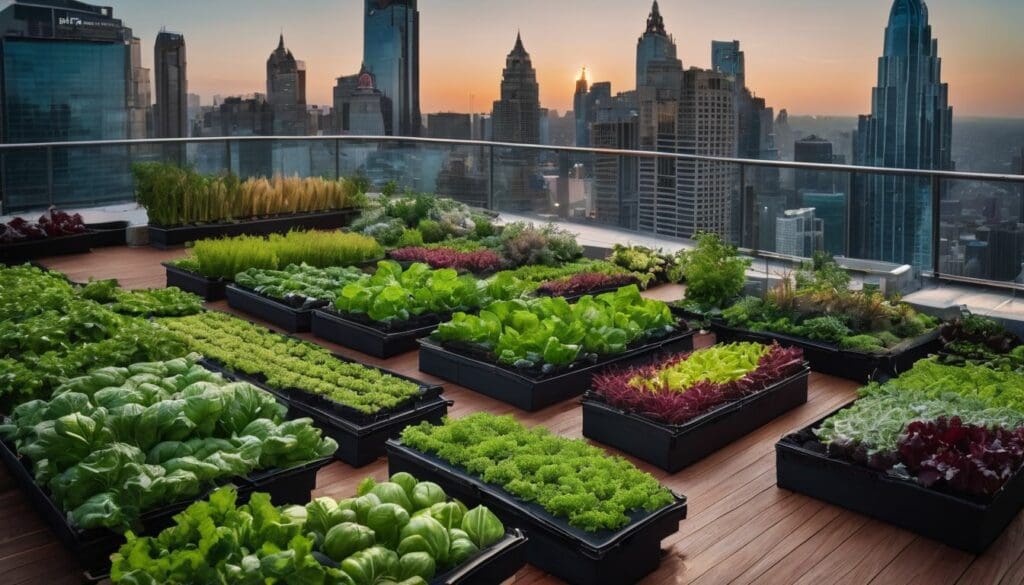Have you ever taken a moment during your bustling city life to pause and ponder where all the verdant touches have disappeared to? It’s something many of us have quietly noted amidst the swathes of concrete — the distinct lack of a charming vegetable plot or even just a splash of greenery.
Fortunately, urban farming is on hand as an inventive remedy to this very conundrum. It allows for flourishing gardens and freshly picked vegetables to weave their way into our urban existence, regardless of traditional garden spaces seemingly being out of reach.
Let’s delve into how we can infuse our grey surroundings with vibrant hues of green and watch as food joyously springs up in the most unexpected places!
Key Takeaways
- Urban farming allows city dwellers to grow food in non-traditional spaces, like rooftops, balconies, and even repurposed shipping containers, making efficient use of under-utilised urban areas.
- Innovative urban farming methods such as vertical farming, hydroponics, aquaponics, and mushroom cultivation adapt to small spaces and can offer fresh produce year-round without traditional land.
- This form of agriculture not only contributes to food security by reducing dependence on distant supply chains but also promotes healthier diets with access to fresh, local produce.
- Urban farms are a source of economic growth and job creation in cities while fostering community spirit and educational opportunities around sustainable living.
- By implementing practices that reduce food waste and utilise resources efficiently; urban farming is at the forefront of creating more resilient urban food systems for the future.
Definition and Explanation of Urban Farming
We see urban farming as an innovative approach to grow food right where we live and work. It involves cultivating, processing, and distributing food in or around city areas. You’ll find crops growing on rooftops, herbs flourishing on balcony gardens, and even livestock being raised in the heart of some cities.
This form of agriculture takes many shapes: vertical farms that scale up our office walls, hydroponic systems in repurposed warehouses, and community gardens dotting the neighbourhoods.
Our interest lies not just in producing sustenance but also fostering educational opportunities and community spirit through these green spaces. Urban agriculture transitions neatly with modern lifestyles; it allows us to source fresh produce without venturing far from our gaming setups – something we can all appreciate! Engaging with this practice means playing a part in sustainable food production while revitalising unused urban areas into vibrant hubs for local food sourcing.
Common Approaches to Urban Farming
Urban farming takes many forms, including vertical farming, hydroponics, aquaponics, shipping container farms, rooftop farming, and mushroom cultivation. Each approach offers a unique way to grow food in urban environments without the need for traditional backyard space.
Vertical Farming
Vertical farming is a cutting-edge urban agriculture method that involves growing crops in vertically stacked layers, often in controlled environments like warehouses or shipping containers.
This innovative approach maximises space utilisation and minimises the need for large areas of land, making it ideal for densely populated urban areas. By using hydroponic or aeroponic systems, vertical farming can produce high yields of fresh, nutrient-rich food without relying on traditional soil-based methods.
Additionally, this technique reduces water usage and eliminates the need for harmful pesticides, offering a sustainable solution to urban food production.
One key benefit of vertical farming is its potential to provide year-round access to locally grown produce, addressing food security issues in cities. Moreover, its efficient use of resources aligns with sustainability goals and reduces the environmental impact associated with conventional agriculture.
Hydroponics
Let’s explore another innovative approach to urban farming: hydroponics. Unlike traditional soil-based farming, hydroponics utilises a nutrient-rich solution to grow plants directly in water, without the need for soil.
This method has gained popularity in urban areas due to its efficient use of space and resources. With hydroponics, plants receive direct access to nutrients, leading to faster growth and higher yields compared to conventional farming methods.
Hydroponic systems can be set up indoors or outdoors, making them suitable for urban environments with limited space. The controlled environment also reduces the risk of pests and diseases, allowing for consistent production of fresh, healthy produce throughout the year.
Aquaponics
Moving on from hydroponics, let’s delve into the world of aquaponics. Aquaponics is a sustainable farming method that combines aquaculture (fish cultivation) with hydroponics (growing plants in water).
In this system, fish waste provides nutrients for the plants, and in turn, the plants purify the water for the fish. It’s an efficient closed-loop cycle where both fish and vegetables thrive symbiotically.
This innovative approach offers several advantages. Not only does it maximise resource use by reusing water and nutrients, but it also reduces environmental impact by minimising water consumption and eliminating chemical fertilisers.
Shipping Container Farms
Shipping container farms are an innovative approach to urban farming, utilising repurposed shipping containers for food production. These contained environments provide a controlled climate for year-round cultivation of various crops, regardless of external weather conditions.
The integration of hydroponic or aquaponic systems optimises the efficient use of water and space, making them well-suited for urban areas with limited land availability. With the ability to be set up in diverse locations, such as vacant lots or rooftops, shipping container farms contribute to enhancing local food security and sustainability while offering a fascinating glimpse into modern agricultural practices.
The adaptability and scalability of shipping container farms make them ideal for urban settings with space constraints. Utilising advanced growing techniques within these compact structures enables communities to access locally grown produce without reliance on distant suppliers, promoting self-sufficiency and reducing carbon emissions associated with long-distance transportation.
Rooftop Farming
Rooftop farming is a method of cultivating food on the tops of buildings within urban environments. This practice utilises otherwise unused space, making it an efficient way to grow fresh produce in cities.
Rooftop gardens not only provide a sustainable source of food but also contribute to reducing urban heat island effects by absorbing sunlight and CO2 emissions. Utilising hydroponic or aeroponic systems, rooftop farms can produce a variety of leafy greens, herbs, and even fruit-bearing plants without soil.
These initiatives play a crucial role in enhancing urban food security and promoting sustainable agriculture in densely populated areas.
Urban dwellers can now grow fresh produce with ease through the use of innovative gardening techniques such as rooftop farming. By adopting these practices, city residents have access to locally-grown organic vegetables and fruits while contributing to the reduction of environmental impact caused by traditional agricultural methods.
Mushrooms
Urban farming also includes the cultivation of mushrooms, which can be grown in small spaces, making them suitable for urban environments. Mushrooms are a valuable source of protein and other essential nutrients, providing an alternative to traditional meat-based proteins.
They can be cultivated indoors or in small outdoor spaces, such as on balconies or in shipping container farms. Growing mushrooms in urban areas not only contributes to food security but also offers an opportunity for city dwellers to engage in sustainable and nutritious food production.
As part of urban farming, the cultivation of mushrooms holds great potential for increasing access to fresh produce and expanding the variety of foods available within cities. By utilising innovative techniques like growing edible fungi, urban farmers can contribute to healthier and more diverse local food systems while creating opportunities for city residents to connect with their food sources.
Benefits of Urban Farming
Urban farming offers increased food security, fresher and healthier foods, urban regeneration and efficient land use, economic growth and job creation, as well as reduced food waste.
To learn more about the benefits of urban farming, keep reading!
Increased food security
Urban farming significantly contributes to increased food security in cities. By growing food locally, urban farms reduce the reliance on distant food supplies, making fresh and culturally appropriate foods more accessible to city dwellers.
This practice directly addresses issues of food insecurity by ensuring a more reliable and sustainable food source within urban areas. Additionally, urban agriculture can also reduce emissions associated with transporting produce from afar, further adding to the resilience of local food systems.
Moreover, urban agriculture diversifies the availability of fresh and healthful foods for city residents, contributing to improved nutrition security. The proximity of production to consumption minimises the time taken for fruits and vegetables to reach consumers, resulting in fresher and healthier options compared to those transported long distances.
Fresher, healthier foods
Urban farming contributes to fresher and healthier foods for city dwellers. By growing produce closer to urban areas, fruits and vegetables can be harvested when they are at their peak ripeness.
This means that the produce retains more nutrients and flavours compared to those that are transported from distant locations. Additionally, urban farms often prioritise organic and sustainable farming methods, resulting in cleaner, pesticide-free food options for consumers.
Access to locally-grown fresh produce also encourages a diet higher in fruits and vegetables, promoting better health outcomes within urban populations.
In addition, the proximity of urban farms to consumers reduces the need for long-term storage or transportation over great distances. As a result, the produce is less likely to lose freshness or nutritional value before it reaches consumers’ plates.
Urban regeneration and use of under-utilised spaces
In addition to providing fresher, healthier foods to urban communities, urban farming facilitates the regeneration of under-utilised spaces within cities. Vacant lots, rooftops, and unused buildings are all potential sites for urban agricultural projects.
By repurposing these neglected areas, urban farming contributes to the revitalisation of neighbourhoods and helps create vibrant community spaces where people can come together over food production and consumption.
This proactive use of under-utilised spaces not only enhances the aesthetic appeal of city landscapes but also fosters a sense of ownership and pride among local residents.
Efficient land use
Urban farming is an efficient use of land in cities, making the most of available space to grow food. Utilising rooftops, vacant lots, and even vertical structures like shipping containers allows for increased food production without the need for large tracts of land.
This approach maximises the potential for agriculture within densely populated urban areas, helping to meet the growing demand for locally grown produce while minimising the environmental impact associated with traditional agricultural practices.
City farming techniques ensure that under-utilised spaces are transformed into productive areas for cultivating fresh, healthy foods. Through small-scale farming and community gardening initiatives, urban dwellers can actively participate in local food production, contributing to improved food security and reduced reliance on distant food supplies.
Economic growth and job creation
Urban farming not only contributes to the local economy but also creates job opportunities within urban communities. As urban agriculture continues to expand, it generates economic growth by providing employment in various areas such as farm management, crop cultivation, sales and distribution, education and research, as well as food processing and packaging.
This not only stimulates economic activity but also helps reduce unemployment rates. The implementation of urban farming initiatives can spark a ripple effect throughout the community through the creation of new businesses that support and supply these farms.
Increased production from urban farming can lead to higher demand for fresh produce, creating more jobs across the entire value chain – from farmers and suppliers to retailers and restaurants – contributing further to economic growth.
Reduced food waste
Reducing food waste is a significant benefit of urban farming. By growing food closer to where it’s consumed, there is less likelihood of spoilage during transportation from distant farms.
Additionally, urban agriculture allows for the use of innovative practices like hydroponics and vertical farming, which can maximise space and yield in small urban areas. As a result, fresher produce reaches consumers more efficiently, reducing the amount of perishable food discarded due to spoilage or overstocking.
Efforts ought to be directed towards ensuring that maximum use is made from limited space within our cities while promoting sustainability. The focus on reduced food waste through urban farming blurs the line between production and consumption cycles leading us into improved practices in city living.
It’s important to experience firsthand how sustainable growth integrates with conscious eating choices when embracing urban agricultural initiatives.
Examples of Successful Urban Farming
– Curtis Stone, a well-known urban farmer and author, has successfully utilised an acre of land in downtown Kelowna, British Columbia to create a thriving organic farm.
– Nature’s Always Right is another successful example, using permaculture principles to grow food on just 1/10th of an acre in San Diego, California.
Curtis Stone
Curtis Stone, an urban farmer and author, has made significant contributions to the urban farming movement through his innovative approach. With his focus on small-scale intensive farming techniques, he demonstrates how it’s possible to grow a significant amount of food in limited space.
By utilising high-yield methods and implementing efficient systems, Stone shows that anyone can produce fresh, healthy produce regardless of living in a city without access to traditional farmland.
Stone’s work emphasises the potential for urban agriculture to address food insecurity and promote sustainability within urban areas. His advocacy for rooftop gardening and indoor farming techniques aligns with the goals of increasing access to locally-grown produce for city dwellers.
Nature’s Always Right
Nature’s Always Right is a prominent urban farming channel on YouTube, providing valuable insights into sustainable and organic gardening techniques. Their focus is on teaching novice and passionate gamers how to grow food in the city using innovative methods such as permaculture, no-dig gardening, and natural pest control.
The channel emphasises the importance of regenerative agriculture and educates viewers about soil health, composting, and water conservation. Nature’s Always Right also showcases the benefits of urban farming for improving food security and promoting sustainable living in urban areas.
With its engaging content and practical advice, Nature’s Always Right has inspired many individuals to start their own urban farms or gardens, contributing to increased access to fresh, locally-grown produce within cities.
FARM
Urban farming is a diverse and adaptable practice that can be implemented in various ways. With enough creativity and innovation, urban farmers are developing new techniques to grow food efficiently within city limits.
From vertical farming to rooftop gardening, the options for growing food in urban areas are expansive. The ability to produce food in non-traditional spaces brings opportunities for increased local food production, improved access to fresh produce, and a more sustainable lifestyle.
Implementing urban farm practices requires an understanding of the unique challenges and opportunities present within a city environment. By utilising under-utilised spaces, such as rooftops or abandoned lots, urban farms contribute to revitalising communities while promoting sustainable living.
As we explore the different approaches of urban farming, it becomes evident that these methods play a crucial role in enhancing community resilience and providing accessible sources of fresh produce within cities.
Conclusion and Encouragement for Urban Farming
In conclusion, urban farming offers an innovative solution to food production in cities. It provides numerous benefits such as increased food security, fresher and healthier produce, efficient land use, economic growth and job creation.
Embracing urban farming not only addresses food insecurity but also promotes sustainability in urban areas. With its potential to transform underutilised spaces into thriving agricultural hubs, urban farming is an inspiring way to cultivate a greener and more self-sufficient future for our cities.
FAQs
1. What is urban farming?
Urban farming lets people grow their own food right in the city, even when they don’t have a backyard.
2. Can I really produce my own food in an urban area?
Yes! You can practice small-scale farming to produce your own fresh food within urban areas, using spaces like balconies or rooftops.
3. Is city farming difficult to start?
Not at all! With some basic knowledge and tools, you can start growing food in the city quite easily.
4. What are the benefits of growing food in the city through urban farming?
Growing your own food in the city saves money, provides fresh eats and reduces your carbon footprint by cutting down on transported goods.





